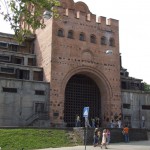Golden Gate (Kiev)
The Golden Gate in Kiev is a monument of fortified construction of the XII century, one of the rare species that has survived till our days. The construction formerly impressed with its grandeur and impregnability: over the mighty battle tower there was the church of Annunciation, which was quite symbolic for a Christian city, since the gate served as the main entrance to Kiev. The Golden Gate was constructed in 1164, after the completion of the defensive embankments of the New City.
It is difficult to imagine that the size of the great city of Yaroslav the Wise was just limited to the present Kiev’s center. The defensive fortress embankments ran through the Lvovskaya Square, where the Lvovskie Gate stood, along the Yaroslavov Val to the Golden Gate, and then descended to the present Independence Square (Maidan Nezalezhnosti) with the Lyadskie Gate (or Lyashskie – that is, Polish); then the embankments climbed upwards to the Mikhailovskaya Square. The overall length of the embankments was 3.5 kilometers. The architectural style of the gate built by Vladimir quite differed from similar edifices erected by the architects from Europe. European constructions, mainly, fulfilled purely protective function as the fortress towers. The Golden Gate in Kiev could be rather compared to the Triumphal Golden Gate in Constantinople. The Kiev Golden Gate was both the fortress pass-through tower and at the same time the triumphal arch, which led to the main “aristocratic street” of the city. The high archway opening, the gate, covered with gilded copper and the dome of the church over the gate created an appropriate solemn atmosphere. The Golden Gate also did not fail its creators down in the hard days of the Tatar siege in 1238. The invaders decided that the city gate was too strong and opted to break the city wall elsewhere with the help of the breaching machines. As time passed, the edifice dilapidated. From the records of the travelers of the 16-17 centuries, and according to some drawings made in 1651, it becomes clear that at that time the Golden Gate was halfway broken, although it had been still keeping the status of the main entrance to Kiev until the middle of the 18th century. It was at the Golden Gate in 1648, where the exultant Kiev citizens welcomed Bohdan Khmelnytsky, who returned with the victory after the battle at Zheltye Vody. Through the Golden Gate Russian delegation solemnly entered Kiev after the uniting of Ukraine and Russia in 1654. On the verge of the 17th and 18th centuries, the reconstruction of fortified edifices in Kiev began, and before the gate earthen bastions were erected. In the middle of the 18th century, the ruins of the monument were covered with dirt and close to their site a new monument was erected under the same name. Only in 1832, the ancient Golden Gate became accessible to the viewers. Kondraty Lokhvitski, using his own means, as well as the money donated through a charity subscription, did excavations that returned to the Kiev dwellers their historic monument. Lokhvitski was an amateur archeologist and his unprofessionalism stirred irritation among professional archeologists, but it is difficult to overemphasize what had been done by Lokhvitski for the history of Kiev. As the result of the excavations, the passage was cleared and the remainders of the earthen embankment were removed on both sides of the gate. Under the architect Vikenty Borisovich Beretti, the ruins were competently and securely strengthened. By the middle of the 20th century, the condition of the Golden Gate aroused serious concern from the scientists. In 1970, there was an idea to close the ancient remains of the monument with a pavilion to protect it from the influence of atmospheric events and also to recreate the original looks of the Golden Gate. So, the ruins would be preserved, and at the same time there would be an opportunity to present to the citizens of Kiev and its guests the monument of history in the appearance that it used to have long time ago. The project of the Golden Gate’s preservation allowed to keep the old stonework completely, including those elements that were added when the remodeling and restoration were carried out in the 17th and 19th centuries. The reconstruction-pavilion “The Golden Gate” was opened in May of 1982, in time for the celebration of the 1500th anniversary of Kiev. Now, within the sections of the embankment there is an exhibition hall, in which one can see the preserved sections of the fortress fortifications; also, there is a stairway, by which one can ascend to the top to enjoy the view of the modern Kiev.

